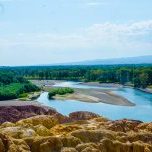Your Majesties, Your Royal Highnesses, Esteemed Nobel Prize Laureates, Esteemed Nobel Prize Laureates in Chemistry 2020 and 2021, Honourable Colleagues, Ladies and Gentlemen,
Chemistry can be hard. Sometimes really hard. One reason for this is the somewhat wild behaviour of atoms and molecules, and the complexity of the environments where they are located. Oftentimes the compounds resist many brave attempts to tame them, to study them, or to use them for our various purposes. However, thanks to our laureates, we now have tools that make this difficult task easier.
Instead of tempering the molecules, arduously persuading them to make the intended connections, which many chemists are indeed very good at doing (!), what about an alternative route? Rather than tailoring every specific connection to perfection, we could use a simpler, more straightforward approach based on very robust ways to make connections. Such chemistry would be so efficient and selective that it would work almost everywhere without complications.
This connection chemistry doesn’t come easy, but around the turn of the millennium, both Morten Meldal and Barry Sharpless discovered a robust chemical reaction that worked in this very straight- forward way. By allowing an azide to react with an alkyne in the presence of copper, a new molecule – a so-called triazole – was very efficiently formed. It was as if the two partner molecules were a perfect match, but needed some help to find each other. The copper ion then acted as a matchmaker and made the two a pair.
In a sense, it just said “click” – and the two were united!
Barry Sharpless called this type of robust chemistry “click chemistry”, and the reaction is sometimes called the click reaction. He envisaged that even rather complex structures could be assembled using such reactions.
At around the same time, Carolyn Bertozzi was studying the very complex world of glycans: sugar structures often present on cell surfaces. To achieve this, she developed robust and efficient, click-type chemistry, also based on azides, that could be performed directly in living systems. The reactions had to be highly selective and not interfere with the myriad of compounds and reactions taking place in such systems. She called this “bioorthogonal chemistry”, and was able to use this to follow the fates of the glycans and decipher intricate biological processes.
The achievements and discoveries of our laureates have had enormous influence on our society. Through the development of inspirational new concepts and highly efficient methods, the laureates have enhanced our capabilities and considerably deepened and widened our knowledge and understanding. Their remarkable chemistry have spurred intense activity across many different areas, which has resulted in a wealth of new, highly important accomplishments.
Carolyn Bertozzi, Morten Meldal, and Barry Sharpless,
You have made groundbreaking discoveries in chemistry that have led to the development of click chemistry and bioorthogonal chemistry. This is a truly great achievement for the benefit of humankind. On behalf of the Royal Swedish Academy of Sciences I wish to convey to you our warmest congratulations. May I now ask you to step forward and receive your Nobel Prizes from the hands of His Majesty the King.
Copyright © The Nobel Foundation 2022
To cite this section
MLA style: Award ceremony speech. NobelPrize.org. Nobel Prize Outreach AB 2022. Sat. 10 Dec 2022. <https://www.nobelprize.org/prizes/chemistry/2022/ceremony-speech/>Back to top
Streams during Nobel Week
Watch the streams from Nobel Week
Watch the 2022 Nobel Prize lectures, the Nobel Prize Concert, Nobel Week Dialogue, the prize award ceremonies in Oslo and Stockholm and Nobel Peace Prize Forum here at nobelprize.org.

Explore prizes and laureates
Look for popular awards and laureates in different fields, and discover the history of the Nobel Prize.Select the category or categories you would like to filter byPhysicsChemistryMedicineLiteraturePeaceEconomic SciencesDecrease the year by one-Choose a year you would like to search inIncrease the year by one+Explore
The Nobel Prize in Chemistry 2022
Share this
The Nobel Prize in Chemistry 2022


